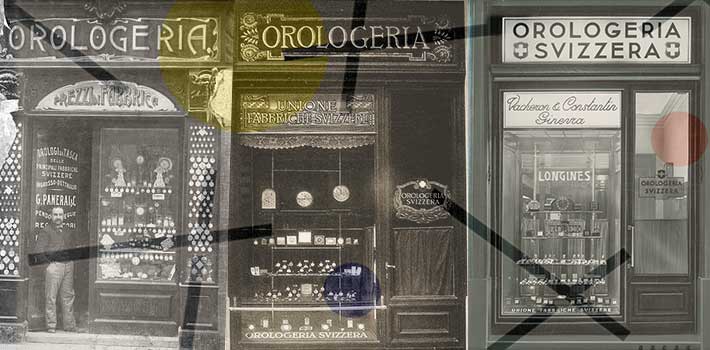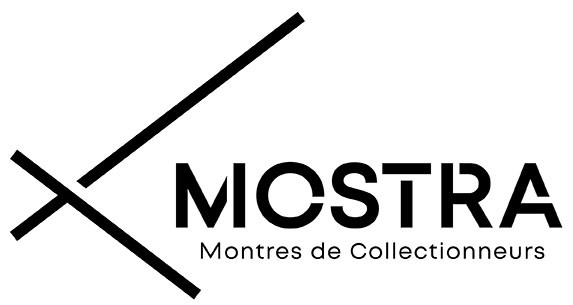
Semper Modum Tempus, Semper Melior
"Always measure time, always be better", a motto that Giovanni Panerai has made his own. Tuscan founder of the “Orologeria Svizzera” trading company, an opulent store of clocks, regulators and pocket watches backed by a repair workshop.
Faithful to the second part of the motto, he will choose Florence, one of the main commercial arteries of the city (they were historically in Italy, located on the bridges), and prefers the "alle Grazie" bridge which overhangs the Arno River in "Ponte Vecchio", the other bridge in the city, more specialized in textiles and spices.
His company will develop rapidly and to meet the growing demand for qualified watchmakers, Giovanni Panerai will open a watchmaking school there, which will enable him, distributing the brands Angelus, Rolex,
and Omega, to begin to design its own models of variant regulators based on calibers and spare parts from these manufactures.
Buoyed by his success and to follow the evolution of town center commerce which was moving towards a location as close as possible to the center, he was to select a prime location for his "pharmacy" located on Piazza San Giovanni, which constitutes the western side of the prestigious Plaza del Duomo.
His company will prosper until becoming one of the suppliers of the Italian Navy which will allow him to develop one of the components of his success and his notoriety: the Radiomir, which before being a watch model was a luminescent substance based on of Radium, with adhesive properties in the aquatic environment which makes it possible to enhance a sighting instrument or an optical device and allow its use at night. An invention less flammable than its phosphorescent equivalents that can be found attached by a patent filed in France by Panerai in March 1916.
Towards the end of the 1920s and always in constant search for improvements, the company run by Guido Panerai and his father, produced the first waterproof cases in its range, following the advances of Rolex, while retaining the bases and mechanisms of pocket watches in the production of regulators and Navy clocks reserved for the Italian army. An experimental production that will lead in 1936 to a model of waterproof wristwatch called the Radiomir prototype intended for the first combat divers of the Italian Navy. For this model, he will use a bracelet attachment system welded to the 47 mm cushion-shaped case, which remains today one of the great classics of the brand and which begins to be produced in series two years later.
It is the beginning of a great collaboration with the Italian Navy, which will see the company now called "G.Panerai et figlio" (to welcome the arrival of Guido, the grandson of the founder in the family business) , become the pioneer craftsman in the manufacture of underwater combat equipment for the elite troops "Somozzatori" or torpedo men of Prince Valerio Borghese. Units of combat swimmers who will shine in the attack on the British fleet stationed in the port of Alexandria during the Second World War. Like the edge dials, the dial of the Panerai Radiomir will gain in visibility by using a "sandwich" structure of superimposed and openwork metal plates for better contrast when reading the luminescent numerals and indexes, and evolved in 1940 , the case by giving it a more massive structure, mountings protected by a more massive fairing and a winding crown with steps and watertight seals by widening the initial conical base of the winding device to form a cylinder. The watch, still equipped with the solid and famous Havana-colored strap of its origins, will have a square buckle that will be taken up by many manufacturers later.
Coming out of the war at the end of the 1940s and still perfecting its models through constant research work, the Panerai pharmacy worked on replacing Radium on the dial, considered "sensitive and radioactive" and directed its efforts towards the development of a new substance composed of Tritium and hydrogen called Luminor. An innovation developed in the mid-1950s and used in its new range of Luminor Panerai diver's watches, which will also receive the brand's characteristic wheel crown protector.
Directly derived from the latest trends that combine an indexed rotating bezel to mark diving times, Officine Panera will equip its Egiziano model, ordered in 50 copies by the Egyptian Navy, with a rotating bezel. A device that will be taken over the following year by Rolex for its Submariner and many others. This watch, which in 1956 was the largest wristwatch in the world, has a Plexiglas glass, blue steel baton hands and a notched indexed rotating bezel that surrounds the dial. An independent small seconds counter inherited from the 1930s returns at nine o'clock. The sixty millimeter steel case protects a caliber P 2002/7 movement made by Panerai on an Angelus 240 movement blank with an eight-day power reserve.
In the 1970s, with the death of Guido Paneria, the last of the line of founders to lead the Company, Panerai remained a manufacturer relatively unknown to the general public. Dino Zei new “commandatore” will expand the range of activities of “Officine Panerai S.r.L. many of whose creations still remain under the veil of secrecy imposed by the Italian Army, such as a left-handed diver's watch. His training as an engineer will allow him to develop many accessories such as depth gauges, compasses and underwater torches that he will market to the Italian Navy.
Following an article in the large-circulation Japanese magazine "TimeSpec" edited by Kesaharu Imai in 1992 and signed by Stephan Ciejka and Thierry Serna, the brand came out of the shadows and the following year, Officine Panerai faced with significant market demand present a collection of three watches produced in a limited series: The Panerai Luminor, Luminor Marina and the Mare Nostrum, which take up the codes of the models of the 1940s, have met with great success. Immediately, these watches of an exceptional diameter for the time appeared on the wrists of many Stars such as Bruce Willis, Arnold Schwarzenegger and Sylvester Stallone and haloed the “pre-Vendôme” collection with a resolutely virile character. It is the beginning of a great notoriety in the world of the collection and with the public. The Richemont Group, (Vendôme Luxury Group today), owner of major watch manufacturers such as Cartier, Vacheron Constantin, Montblanc, Baume & Mercier or Piaget will acquire under the beard of Rolex or SMH (Nicolas Hayek's Swatch Group) the watchmaking nugget that is the watch department of the Officine Panerai. Officine Panerai moves its new Manufacture to Neuchâtel, Switzerland and opens to international distribution with a boutique in Hong Kong, the study of a new “Manufacture” range and the opening to distribution. The year 2005 celebrates the arrival of the first manufacture movement, the P2002 caliber manufactured by Panerai and inspired by the Angelus movements fitted to Panerai watches from the Second World War, affirming, if necessary, the Nautical and technical character of its models.
It will be from this moment a return to the sources with the restoration of the "historic" shop of the pizza del Duomo in Florence and a production of GMT models and reissues in limited series which today delight amateurs and of collectors.

